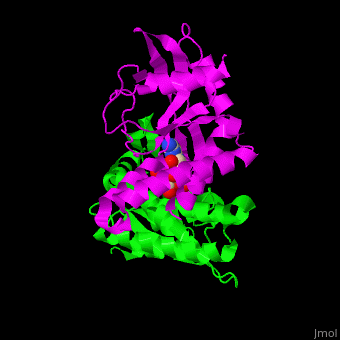Stimulator of interferon genes: Difference between revisions
Jump to navigation
Jump to search
Michal Harel (talk | contribs) No edit summary |
No edit summary |
||
| Line 1: | Line 1: | ||
<StructureSection load='4loh' size=' | <StructureSection load='4loh' size='450' side='right' caption='Structure of human STING CTD complex with c-GMP-AMP (PDB entry [[4loh]])' scene='57/573101/Cv/1'> | ||
'''Stimulator of interferon genes''' (STING) induces production of type I interferon when cells are infected by viruses, mycobacteria and intracellular parasites. STING recognizes and binds cyclic-di-GMP produced by bacteria and cyclic-GMP AMP (cGAMP) produced by viruses. The C-terminal domain (CTD) (residues 139-379 in human) of STING binds cyclic-di-GMP. STING is a facilitator of innate immune signaling<ref>PMID:26980676</ref>. | '''Stimulator of interferon genes''' (STING) induces production of type I interferon when cells are infected by viruses, mycobacteria and intracellular parasites. STING recognizes and binds cyclic-di-GMP produced by bacteria and cyclic-GMP AMP (cGAMP) produced by viruses. The C-terminal domain (CTD) (residues 139-379 in human) of STING binds cyclic-di-GMP. STING is a facilitator of innate immune signaling<ref>PMID:26980676</ref>. | ||
Revision as of 14:34, 1 September 2016
Stimulator of interferon genes (STING) induces production of type I interferon when cells are infected by viruses, mycobacteria and intracellular parasites. STING recognizes and binds cyclic-di-GMP produced by bacteria and cyclic-GMP AMP (cGAMP) produced by viruses. The C-terminal domain (CTD) (residues 139-379 in human) of STING binds cyclic-di-GMP. STING is a facilitator of innate immune signaling[1]. Structural highlightsThe cyclic dinucleotide binds the STING in a U-shaped cleft between the 2 monomers[2]. |
| ||||||||||
3D structures of STING3D structures of STING
(Updated on 01-September-2016
ReferencesReferences
- ↑ Poltorak A, Kurmyshkina O, Volkova T. Stimulator of interferon genes (STING): A "new chapter" in virus-associated cancer research. Lessons from wild-derived mouse models of innate immunity. Cytokine Growth Factor Rev. 2016 Jun;29:83-91. doi:, 10.1016/j.cytogfr.2016.02.009. Epub 2016 Mar 4. PMID:26980676 doi:http://dx.doi.org/10.1016/j.cytogfr.2016.02.009
- ↑ Gao P, Ascano M, Zillinger T, Wang W, Dai P, Serganov AA, Gaffney BL, Shuman S, Jones RA, Deng L, Hartmann G, Barchet W, Tuschl T, Patel DJ. Structure-Function Analysis of STING Activation by c[G(2',5')pA(3',5')p] and Targeting by Antiviral DMXAA. Cell. 2013 Aug 15;154(4):748-62. doi: 10.1016/j.cell.2013.07.023. Epub 2013 Aug, 1. PMID:23910378 doi:10.1016/j.cell.2013.07.023
